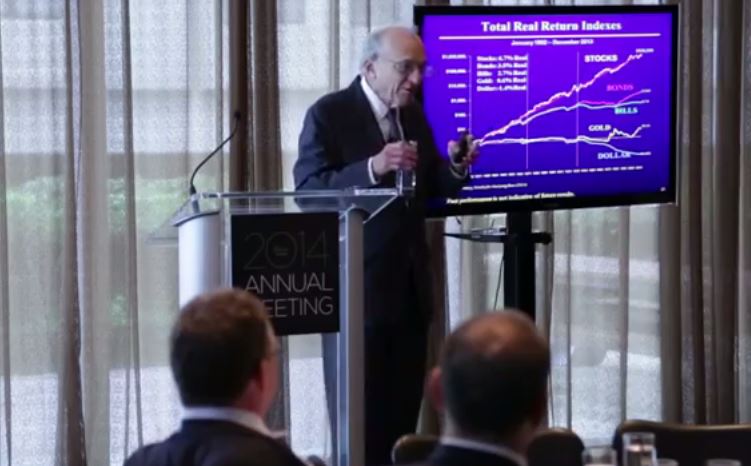At our Annual Meeting this year, our closing keynote did not disappoint. Dr. Jeremy Siegel is a Russell E. Palmer Professor of Finance at Wharton, and best-selling author of Stocks for the Long Run, whose fifth edition was named by the Washington Post and Business Week as one of the ten-best business books of all time. Known as the “Wizard of Wharton,” Dr. Siegel is an unabashed, legendary Bull about the stock market. He lived up to his reputation as he discussed stock market returns, trends and outlook.

Dr. Siegel shared four key insights:
1. In the long run, stocks are the best, most stable investment.
It’s clear from Dr. Siegel’s analysis, that over the long term (since the end of World War II), the stock market’s 6-7% annual return outperforms all other asset classes by 350-600 basis points. That amounts to stocks delivering 600X+ higher total returns than other asset classes over a 30-year timeframe. Dr. Siegel also noted, “The bull market from 1981-1999 was one of greatest bull markets in history with returns that were double the long-term average.”
Stocks are volatile in the short term, quarter- by-quarter, year-by-year. But stocks yield the most stable, consistent returns in the long run (20, 30 and >50 years) -- a startling fact considering the regular debates between institutional investors, the financial press and market research about allocation among asset classes.
2. More economic and stock market growth ahead.
Dr. Siegel predicted the Dow would surpass 16,000 in 2014, and he forecasts Dow 20,000 in 2015. He believes stocks are currently tracking to the long term valuation trend-line, after being well above in 2000 and well below in 2009. Based on economic growth outlook of 2%, which continues to keep interest rates low, and a structural understatement of public company earnings, he sees room for 10-15% stock market increase from current levels. Steady GDP expansion is good news for companies as they plan for driving growth . A stock market that continues to climb is positive for the M&A and IPO environment.
3. Real-Rates are the baseline for stock valuations.
Primary determinants of Real-Rates are:
- Economic Growth single most important determinant of real rates
- Average GDP Growth Rate between 1960 and 2008 was 3.4%
- CBO Predicts growth between 1.5% and 2% over next ten years
- Short-term Real Rate should be much lower, probably less than 1%
With Real Rates at historically low levels, stock valuations and stock market levels have room to climb up further.

4. Investors require higher returns, which growth equity funds can deliver.
On a related note, stock market returns of 6-7% are the best investors can achieve in the public markets, over the long term., And that is much better than other major asset classes like bonds, treasuries, gold or currencies. This is also why institutional investors seek alternative asset classes -- including growth equity funds like Edison Partners that deliver 600-800 basis points higher annual return and 700X+ higher total return versus the stock market, over nearly 30 years. These results, in the long run, add real value to institutional portfolios and compensate for illiquidity and the risk profile associated with private/growth equity funds.
We thank Dr. Siegel for his outspoken and compelling insights. Let us know what you think by commenting below or feel free to also share your thoughts on this topic directly with me at stotia@edisonpartners.com.


.png)